I was fortunate enough to be able to work in and arrange to travel to Corvallis, Oregon and visit Oregon State University, go Beavers! This was a wonderful chance for me to do a little more pre-expedition planning, and more fully understand the process and importance of the research I am participating in.
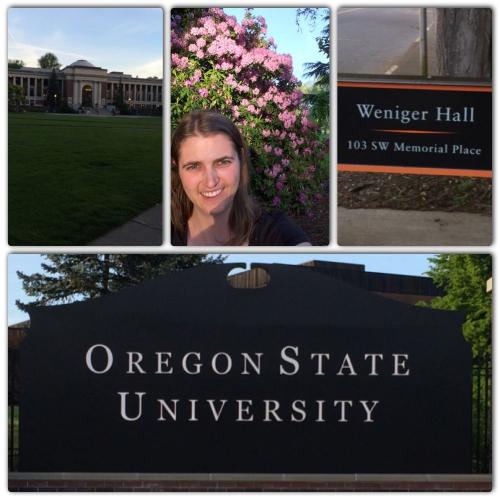 Visiting Oregon State University in Corvallis, OR to meet Dr. Byron Crump
Visiting Oregon State University in Corvallis, OR to meet Dr. Byron Crump
The Research Team!
Dr. Byron Crump is the principal investigator, or PI in research lingo, for my expedition to the Arctic. He is a professor at Oregon State University, and has been there for just about one year. Previously he also researched and worked Maryland for around a decade. He developed the idea for this project, and it is currently in its seventh out of ten years. He loves little microbes and all of the small, itty bitty, teeny tiny critters that make the world go round.
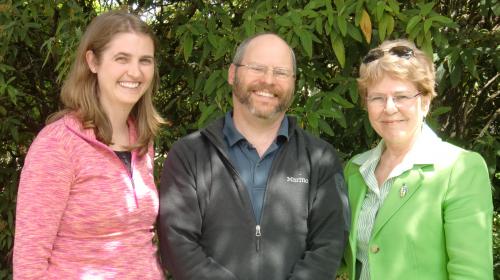 From left to right, PolarTREC teacher Lauren Watel, PolarTREC researcher Dr. Byron Crump and former Undersecretary of Commerce for Oceans and Atmosphere Dr. Jane Lubchenco
From left to right, PolarTREC teacher Lauren Watel, PolarTREC researcher Dr. Byron Crump and former Undersecretary of Commerce for Oceans and Atmosphere Dr. Jane Lubchenco
I also met Sarah Nalven, a new graduate student, who will be joining us in the field. She will be the person collecting all of the remaining samples after Byron and I leave in early July. She gets to spend all summer at Toolik! She also does a lot of the lab work associated with preparing the samples shipped back from the field and getting them ready for further analysis.
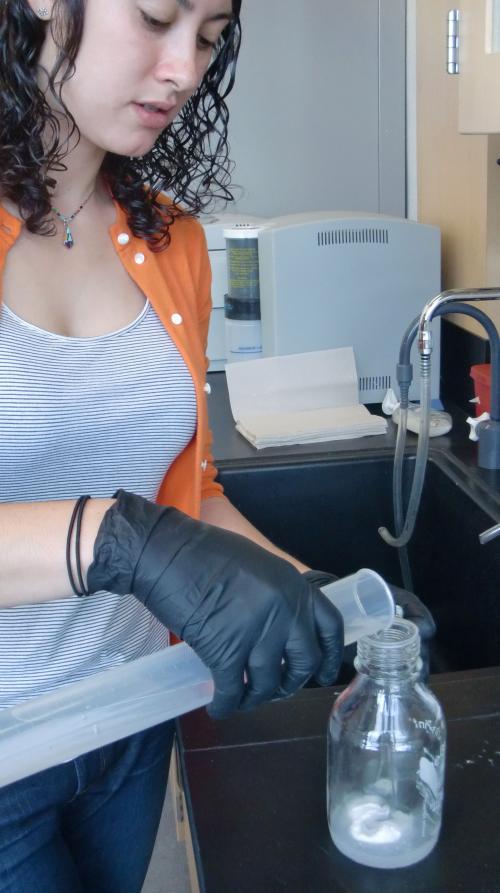 Sarah Nalven making agarose gel
Sarah Nalven making agarose gel
What we checked out
Once we collect samples and prepare them at Toolik over the summer we will ship them back to OSU. It's important to understand what happens to all of the samples that have been collected in past years, and ones we will collect this summer, from the areas in and around Toolik Lake. Essentially lots of little tubes get stored in the freezer. Each one contains a sample of microbial DNA from a specific date and location. Each tube is labeled with a code that has been recorded so that they can be matched up later.
Polymerase Chain Reaction (PCR)
Sarah was working on many of the samples from previous years and taking them through some different reactions and tests. She would take each sample and run a small portion through what is called the polymerase chain reaction, or PCR in science lingo. This takes a small amount of DNA and copies it to make lots and lots of copies of the same sequence. (I will explain this process more in a future entry)
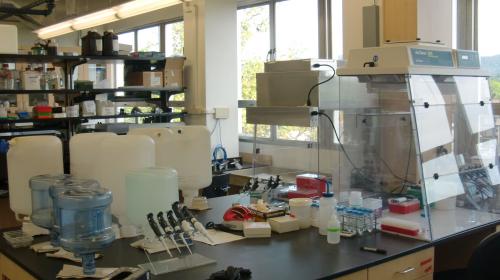 Byron's lab, this is the area where PCR is completed
Byron's lab, this is the area where PCR is completed
Gel Electrophoresis
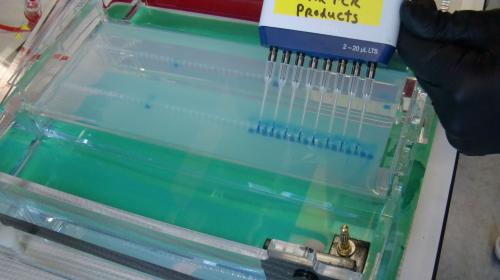 The blue dyed bacterial DNA is inserted into small wells in the gel. Each well represents a different sample collected from past fieldwork. A gel this size can run 96 samples simultaneously!
The blue dyed bacterial DNA is inserted into small wells in the gel. Each well represents a different sample collected from past fieldwork. A gel this size can run 96 samples simultaneously!
She then takes some of this DNA and runs it through a process called gel electrophoresis so that we can visually check if the gene Byron is interested in- called 16s- has enough copies present so that it shows up in the samples. (Again I will explain this process more in a future entry)
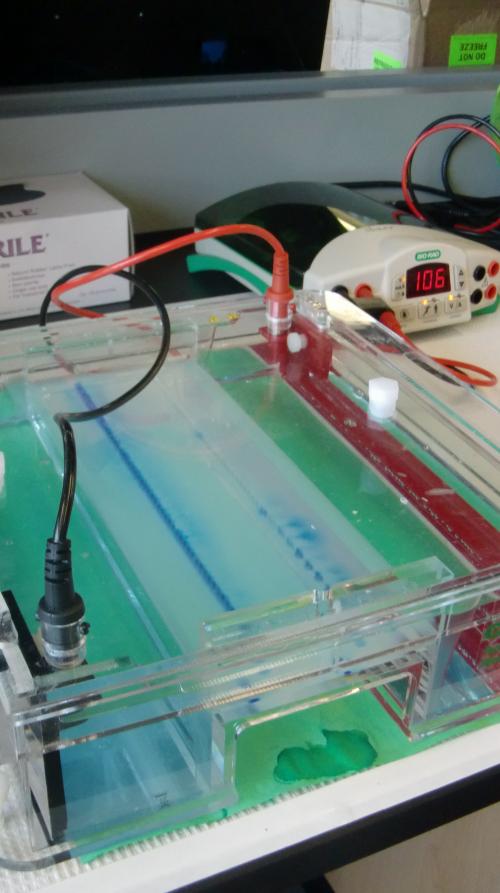 Once the DNA samples are loaded into the gel an electrical current is run through the box to pull the DNA samples through the gel to separate them by size.
Once the DNA samples are loaded into the gel an electrical current is run through the box to pull the DNA samples through the gel to separate them by size.
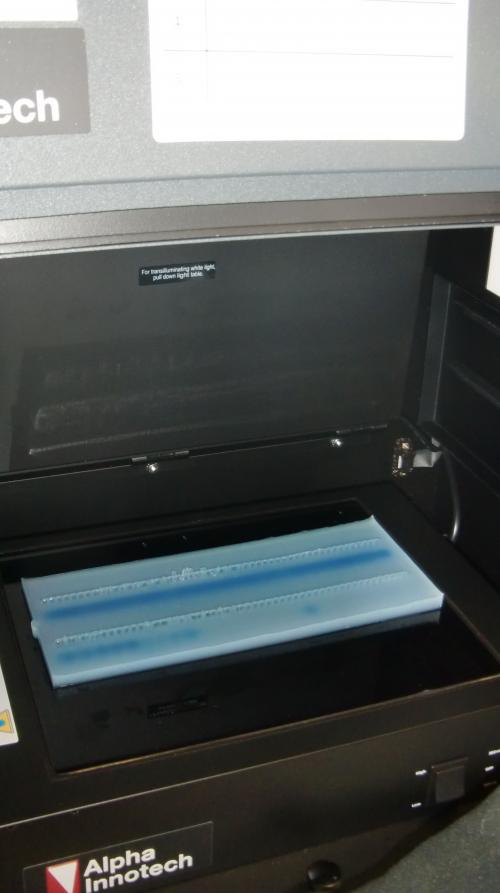 After the DNA samples have moved through the gel we place the gel on a ultraviolet (UV) light table and take a picture of the bands that show up. Sarah then checks each sample to see if there is enough of the 16s gene present for sequencing.
After the DNA samples have moved through the gel we place the gel on a ultraviolet (UV) light table and take a picture of the bands that show up. Sarah then checks each sample to see if there is enough of the 16s gene present for sequencing.
Gene Sequencing
Once we know that the gene Byron is interested in is present in large enough amounts the DNA samples- remember we made lots and lots of copies earlier- it can be sent over to a different lab on campus- called CGRB to be sequenced. This means that they run it through a machine that can tell them just what order the nucleotides in that 16s gene are in (how many A, T, C, G and what order they are in). Think about this as a machine that you could put something into that you wanted to understand how to make, and it would spit out an instruction manual for you.
How This Data is Used
Byron also explained and shared some of the data that he has collected from the past six years of this project (all of those A, T, C, and G sequences) and explained more about how he can utilize them and draw conclusions. This helps to give a context to understand what his data is showing, and how and why it is important.
Other Benefits
Our visit also allowed us to better understand what the other hopes to take away from our collaboration and should help make our field time as worthwhile as possible. It's Byron's first time hosting a PolarTREC teacher as well, so it was important for us to chat about our program expectations and requirements.
We also got to know each other! This relationship is very important as we will be spending a lot of time together this summer- including a couple of loooong rides to and from Toolik. This initial visit should make our teamwork more effective in the field!
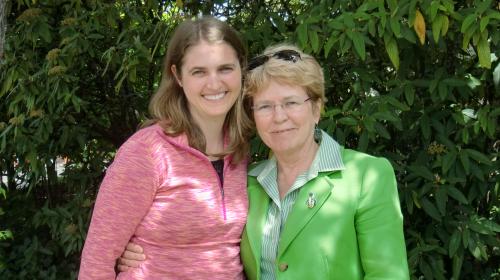 PolarTREC teacher Lauren Watel and Dr. Jane Lubchenco, a St. Mary's Academy and Colorado College alumna!
PolarTREC teacher Lauren Watel and Dr. Jane Lubchenco, a St. Mary's Academy and Colorado College alumna!
This visit should allow me to ensure that you also able to take away a better understanding of Byron's research and has helped me think about how to tell you his, and our, story from the Arctic. A major component of this and thinking about how to convey Byron's research was having the opportunity to visit with Dr. Jane Lubchenco another professor at OSU, and an alumna of St. Mary's Academy and my undergraduate college- Colorado College- as well! Not to mention she was the former Undersecretary of Commerce for Oceans and Atmosphere during the first term of President Obama, this also involved serving as the Administrator of the National Oceanic and Atmospheric Administration, or NOAA.
I plan on sharing some of my experiences from this trip with you now, but also revisiting the lab later on during the expedition this summer.


Comments